LCBB6001 - International Business Communication: Sainsbury in Japan
VerifiedAdded on 2023/06/18
|10
|3246
|336
Report
AI Summary
This report explores the complexities of international business communication, focusing on Sainsbury's expansion into Japan. It begins by defining international business and introducing Japan's cultural landscape. The report then applies Hofstede's Cultural Dimensions model to compare the UK and Japan, highlighting differences in power distance, individualism, masculinity, uncertainty avoidance, and indulgence. It further examines cultural sensitivity in Japan, emphasizing the importance of language, religion, and social norms. The report identifies potential communication barriers, including linguistic and psychological differences, and recommends effective communication strategies to mitigate these challenges. The analysis aims to provide insights for Sainsbury's to navigate the intricacies of cross-cultural communication and succeed in the Japanese market. Desklib provides access to a wealth of study resources, including past papers and solved assignments, to support students in their academic pursuits.
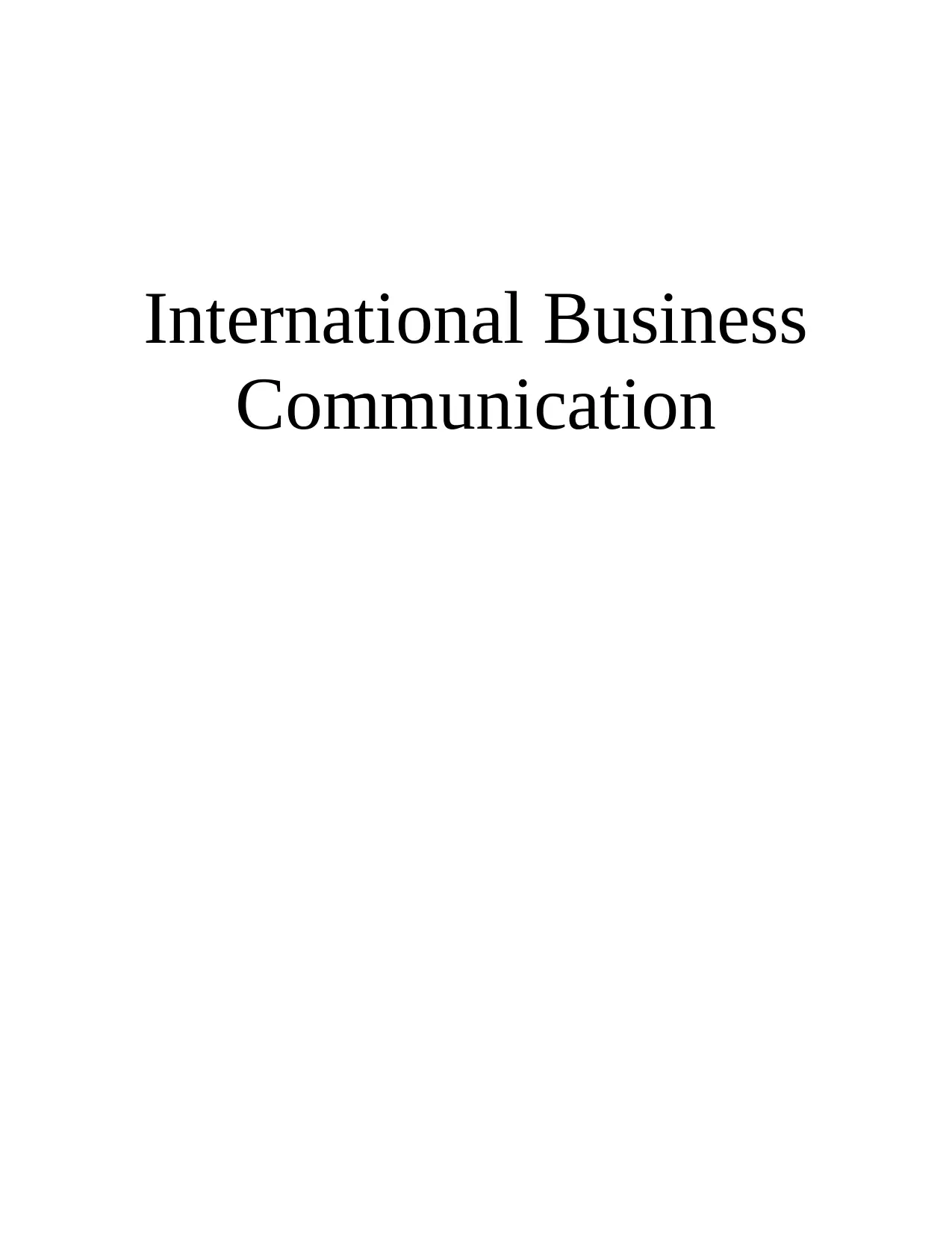
International Business
Communication
Communication
Paraphrase This Document
Need a fresh take? Get an instant paraphrase of this document with our AI Paraphraser
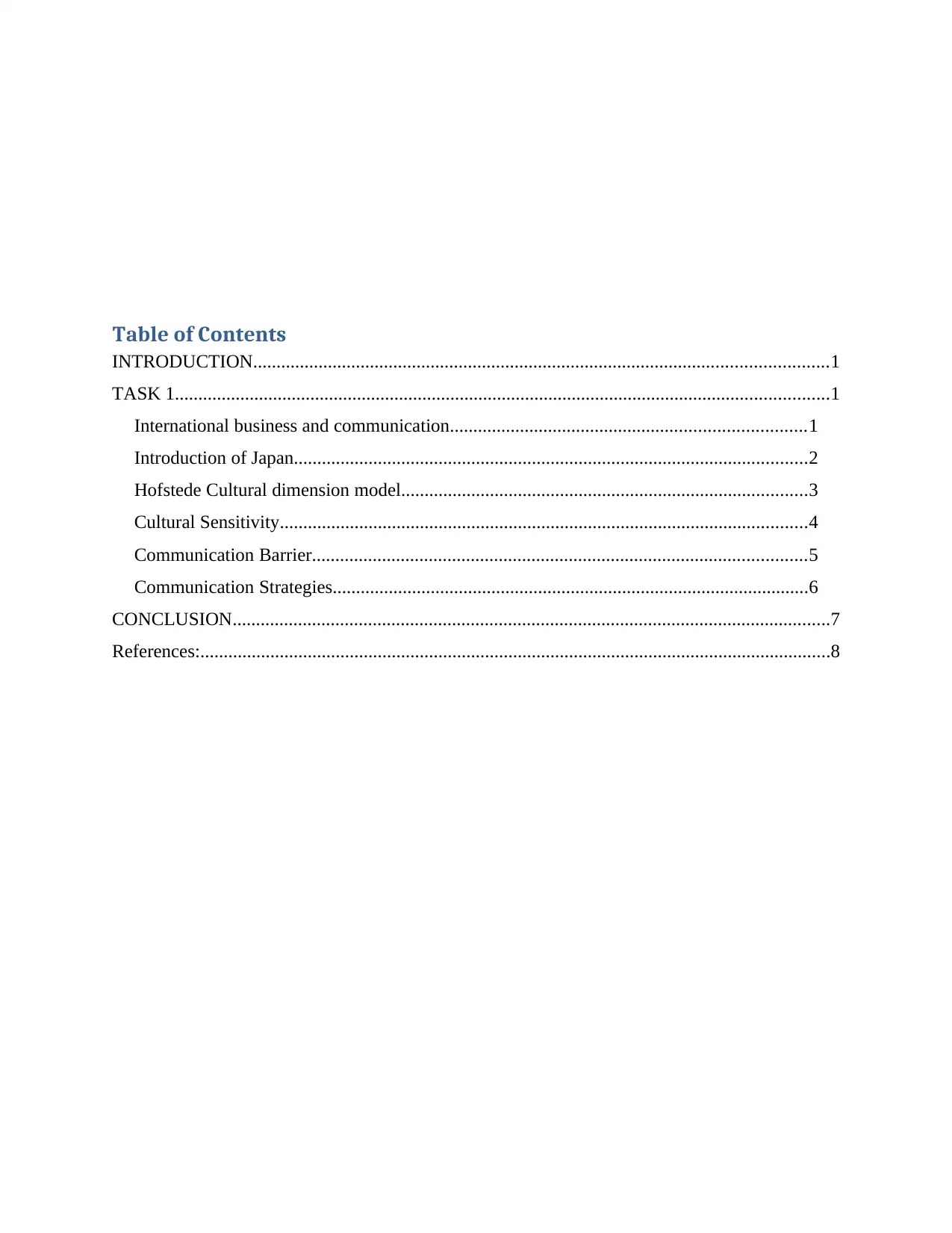
Table of Contents
INTRODUCTION...........................................................................................................................1
TASK 1............................................................................................................................................1
International business and communication............................................................................1
Introduction of Japan..............................................................................................................2
Hofstede Cultural dimension model.......................................................................................3
Cultural Sensitivity.................................................................................................................4
Communication Barrier..........................................................................................................5
Communication Strategies......................................................................................................6
CONCLUSION................................................................................................................................7
References:.......................................................................................................................................8
INTRODUCTION...........................................................................................................................1
TASK 1............................................................................................................................................1
International business and communication............................................................................1
Introduction of Japan..............................................................................................................2
Hofstede Cultural dimension model.......................................................................................3
Cultural Sensitivity.................................................................................................................4
Communication Barrier..........................................................................................................5
Communication Strategies......................................................................................................6
CONCLUSION................................................................................................................................7
References:.......................................................................................................................................8

INTRODUCTION
International business is the term that refers to the trading of goods and services across
the national borders. The rapid increase in technology is significantly prompting the business
towards international business activities. International business communication aims at the
effective interaction between two business partners of two different nations. For international
business and trade organisations adopt different methods such as franchising, e-commerce, joint
venture, licensing etc. The international communication has become important for the global
business community in order to maintain peace and to learn from each other. The present report
is about a UK based organisation “Sainsbury” a supermarket headquartered in London, UK. The
company is moving its production into developing country Japan. The report will discuss the
concept of international business and communication and briefly introduce the developing
country. Further in the report Hofstede Model is discussed and cultural sensitivity of Japan is
critically evaluated. Different communication barrier are discussed and appropriate
communication strategy are recommended in order to enable company to succeed.
TASK 1
International business and communication
International business is term used to define the cross border trading of goods and
services along with the technology and capital. In order to conduct the international business a
business man must have adequate knowledge of culture and society of the new country. The
international business also includes the production of the goods and service across the borders.
The current business environment is full of competition and also resources available in different
countries are valuable to other countries too (Alshurideh, Al Kurdi and Salloum, 2021) . The
globalisation is forcing the business to operate in other countries to gain their market
opportunities such reduced cost of production etc. Hence to conduct international business and
effective communication between two nations is mandatory. The multi linguistic communication
or inter culture communication is vital part of internation business and to succeed in business the
communication must be barrier free. With increased facility of internet services the members of
global community must communicate with each other in order to understand each other’s
cultural and also to omit the disruption of cultural sensitivity. Thus digital communication
channels have high potential in order to have smooth communication in cross cultural.
1
International business is the term that refers to the trading of goods and services across
the national borders. The rapid increase in technology is significantly prompting the business
towards international business activities. International business communication aims at the
effective interaction between two business partners of two different nations. For international
business and trade organisations adopt different methods such as franchising, e-commerce, joint
venture, licensing etc. The international communication has become important for the global
business community in order to maintain peace and to learn from each other. The present report
is about a UK based organisation “Sainsbury” a supermarket headquartered in London, UK. The
company is moving its production into developing country Japan. The report will discuss the
concept of international business and communication and briefly introduce the developing
country. Further in the report Hofstede Model is discussed and cultural sensitivity of Japan is
critically evaluated. Different communication barrier are discussed and appropriate
communication strategy are recommended in order to enable company to succeed.
TASK 1
International business and communication
International business is term used to define the cross border trading of goods and
services along with the technology and capital. In order to conduct the international business a
business man must have adequate knowledge of culture and society of the new country. The
international business also includes the production of the goods and service across the borders.
The current business environment is full of competition and also resources available in different
countries are valuable to other countries too (Alshurideh, Al Kurdi and Salloum, 2021) . The
globalisation is forcing the business to operate in other countries to gain their market
opportunities such reduced cost of production etc. Hence to conduct international business and
effective communication between two nations is mandatory. The multi linguistic communication
or inter culture communication is vital part of internation business and to succeed in business the
communication must be barrier free. With increased facility of internet services the members of
global community must communicate with each other in order to understand each other’s
cultural and also to omit the disruption of cultural sensitivity. Thus digital communication
channels have high potential in order to have smooth communication in cross cultural.
1
⊘ This is a preview!⊘
Do you want full access?
Subscribe today to unlock all pages.

Trusted by 1+ million students worldwide
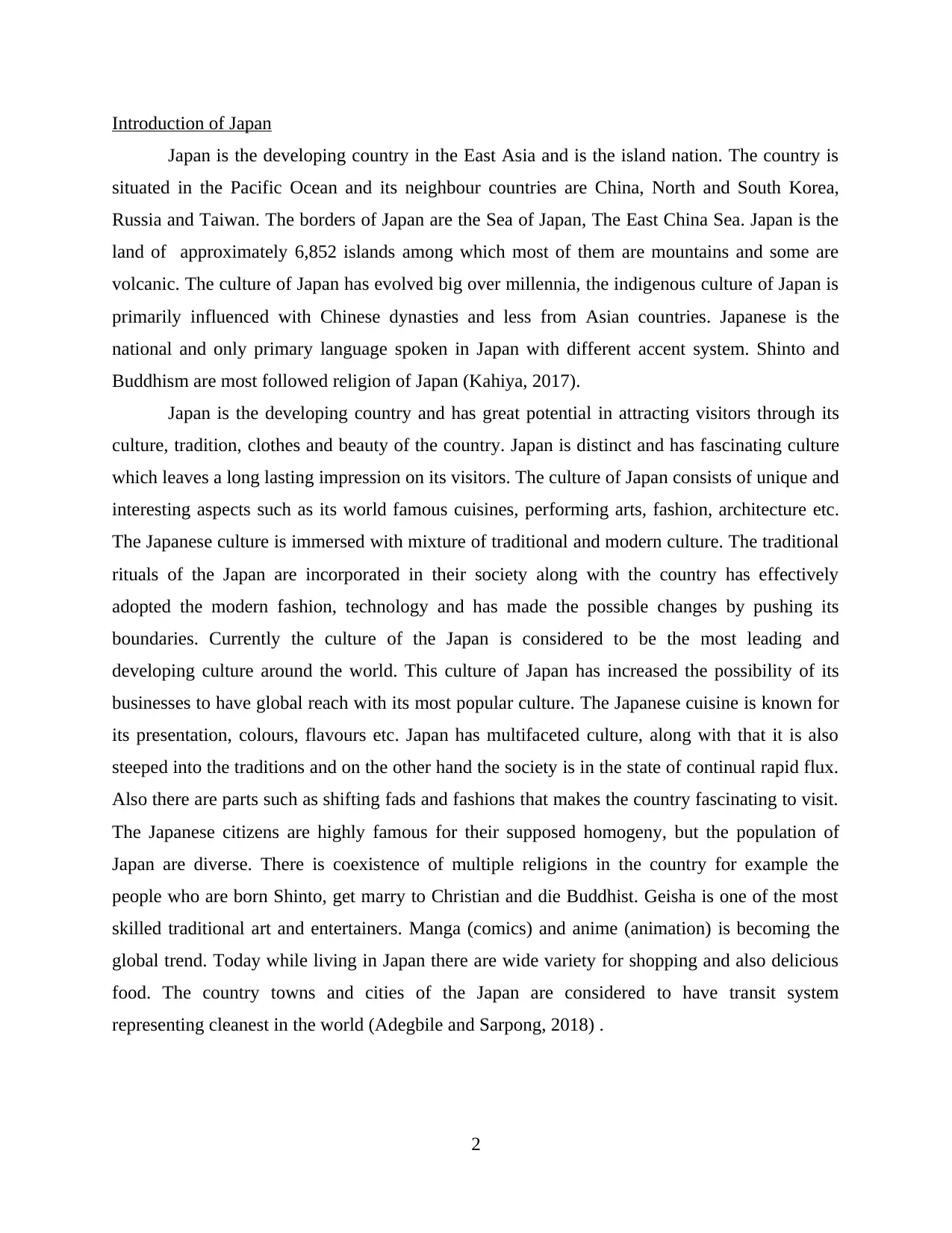
Introduction of Japan
Japan is the developing country in the East Asia and is the island nation. The country is
situated in the Pacific Ocean and its neighbour countries are China, North and South Korea,
Russia and Taiwan. The borders of Japan are the Sea of Japan, The East China Sea. Japan is the
land of approximately 6,852 islands among which most of them are mountains and some are
volcanic. The culture of Japan has evolved big over millennia, the indigenous culture of Japan is
primarily influenced with Chinese dynasties and less from Asian countries. Japanese is the
national and only primary language spoken in Japan with different accent system. Shinto and
Buddhism are most followed religion of Japan (Kahiya, 2017).
Japan is the developing country and has great potential in attracting visitors through its
culture, tradition, clothes and beauty of the country. Japan is distinct and has fascinating culture
which leaves a long lasting impression on its visitors. The culture of Japan consists of unique and
interesting aspects such as its world famous cuisines, performing arts, fashion, architecture etc.
The Japanese culture is immersed with mixture of traditional and modern culture. The traditional
rituals of the Japan are incorporated in their society along with the country has effectively
adopted the modern fashion, technology and has made the possible changes by pushing its
boundaries. Currently the culture of the Japan is considered to be the most leading and
developing culture around the world. This culture of Japan has increased the possibility of its
businesses to have global reach with its most popular culture. The Japanese cuisine is known for
its presentation, colours, flavours etc. Japan has multifaceted culture, along with that it is also
steeped into the traditions and on the other hand the society is in the state of continual rapid flux.
Also there are parts such as shifting fads and fashions that makes the country fascinating to visit.
The Japanese citizens are highly famous for their supposed homogeny, but the population of
Japan are diverse. There is coexistence of multiple religions in the country for example the
people who are born Shinto, get marry to Christian and die Buddhist. Geisha is one of the most
skilled traditional art and entertainers. Manga (comics) and anime (animation) is becoming the
global trend. Today while living in Japan there are wide variety for shopping and also delicious
food. The country towns and cities of the Japan are considered to have transit system
representing cleanest in the world (Adegbile and Sarpong, 2018) .
2
Japan is the developing country in the East Asia and is the island nation. The country is
situated in the Pacific Ocean and its neighbour countries are China, North and South Korea,
Russia and Taiwan. The borders of Japan are the Sea of Japan, The East China Sea. Japan is the
land of approximately 6,852 islands among which most of them are mountains and some are
volcanic. The culture of Japan has evolved big over millennia, the indigenous culture of Japan is
primarily influenced with Chinese dynasties and less from Asian countries. Japanese is the
national and only primary language spoken in Japan with different accent system. Shinto and
Buddhism are most followed religion of Japan (Kahiya, 2017).
Japan is the developing country and has great potential in attracting visitors through its
culture, tradition, clothes and beauty of the country. Japan is distinct and has fascinating culture
which leaves a long lasting impression on its visitors. The culture of Japan consists of unique and
interesting aspects such as its world famous cuisines, performing arts, fashion, architecture etc.
The Japanese culture is immersed with mixture of traditional and modern culture. The traditional
rituals of the Japan are incorporated in their society along with the country has effectively
adopted the modern fashion, technology and has made the possible changes by pushing its
boundaries. Currently the culture of the Japan is considered to be the most leading and
developing culture around the world. This culture of Japan has increased the possibility of its
businesses to have global reach with its most popular culture. The Japanese cuisine is known for
its presentation, colours, flavours etc. Japan has multifaceted culture, along with that it is also
steeped into the traditions and on the other hand the society is in the state of continual rapid flux.
Also there are parts such as shifting fads and fashions that makes the country fascinating to visit.
The Japanese citizens are highly famous for their supposed homogeny, but the population of
Japan are diverse. There is coexistence of multiple religions in the country for example the
people who are born Shinto, get marry to Christian and die Buddhist. Geisha is one of the most
skilled traditional art and entertainers. Manga (comics) and anime (animation) is becoming the
global trend. Today while living in Japan there are wide variety for shopping and also delicious
food. The country towns and cities of the Japan are considered to have transit system
representing cleanest in the world (Adegbile and Sarpong, 2018) .
2
Paraphrase This Document
Need a fresh take? Get an instant paraphrase of this document with our AI Paraphraser
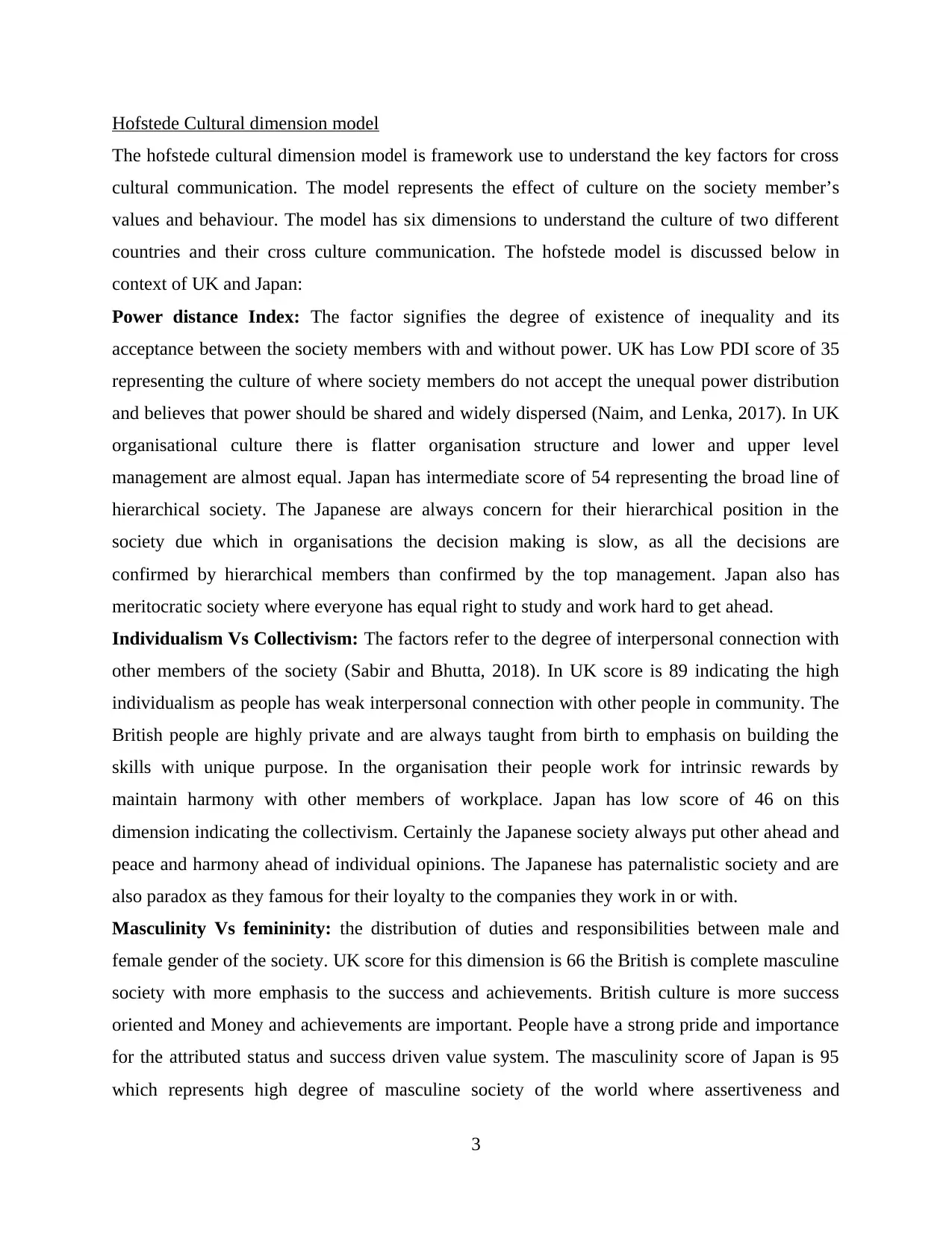
Hofstede Cultural dimension model
The hofstede cultural dimension model is framework use to understand the key factors for cross
cultural communication. The model represents the effect of culture on the society member’s
values and behaviour. The model has six dimensions to understand the culture of two different
countries and their cross culture communication. The hofstede model is discussed below in
context of UK and Japan:
Power distance Index: The factor signifies the degree of existence of inequality and its
acceptance between the society members with and without power. UK has Low PDI score of 35
representing the culture of where society members do not accept the unequal power distribution
and believes that power should be shared and widely dispersed (Naim, and Lenka, 2017). In UK
organisational culture there is flatter organisation structure and lower and upper level
management are almost equal. Japan has intermediate score of 54 representing the broad line of
hierarchical society. The Japanese are always concern for their hierarchical position in the
society due which in organisations the decision making is slow, as all the decisions are
confirmed by hierarchical members than confirmed by the top management. Japan also has
meritocratic society where everyone has equal right to study and work hard to get ahead.
Individualism Vs Collectivism: The factors refer to the degree of interpersonal connection with
other members of the society (Sabir and Bhutta, 2018). In UK score is 89 indicating the high
individualism as people has weak interpersonal connection with other people in community. The
British people are highly private and are always taught from birth to emphasis on building the
skills with unique purpose. In the organisation their people work for intrinsic rewards by
maintain harmony with other members of workplace. Japan has low score of 46 on this
dimension indicating the collectivism. Certainly the Japanese society always put other ahead and
peace and harmony ahead of individual opinions. The Japanese has paternalistic society and are
also paradox as they famous for their loyalty to the companies they work in or with.
Masculinity Vs femininity: the distribution of duties and responsibilities between male and
female gender of the society. UK score for this dimension is 66 the British is complete masculine
society with more emphasis to the success and achievements. British culture is more success
oriented and Money and achievements are important. People have a strong pride and importance
for the attributed status and success driven value system. The masculinity score of Japan is 95
which represents high degree of masculine society of the world where assertiveness and
3
The hofstede cultural dimension model is framework use to understand the key factors for cross
cultural communication. The model represents the effect of culture on the society member’s
values and behaviour. The model has six dimensions to understand the culture of two different
countries and their cross culture communication. The hofstede model is discussed below in
context of UK and Japan:
Power distance Index: The factor signifies the degree of existence of inequality and its
acceptance between the society members with and without power. UK has Low PDI score of 35
representing the culture of where society members do not accept the unequal power distribution
and believes that power should be shared and widely dispersed (Naim, and Lenka, 2017). In UK
organisational culture there is flatter organisation structure and lower and upper level
management are almost equal. Japan has intermediate score of 54 representing the broad line of
hierarchical society. The Japanese are always concern for their hierarchical position in the
society due which in organisations the decision making is slow, as all the decisions are
confirmed by hierarchical members than confirmed by the top management. Japan also has
meritocratic society where everyone has equal right to study and work hard to get ahead.
Individualism Vs Collectivism: The factors refer to the degree of interpersonal connection with
other members of the society (Sabir and Bhutta, 2018). In UK score is 89 indicating the high
individualism as people has weak interpersonal connection with other people in community. The
British people are highly private and are always taught from birth to emphasis on building the
skills with unique purpose. In the organisation their people work for intrinsic rewards by
maintain harmony with other members of workplace. Japan has low score of 46 on this
dimension indicating the collectivism. Certainly the Japanese society always put other ahead and
peace and harmony ahead of individual opinions. The Japanese has paternalistic society and are
also paradox as they famous for their loyalty to the companies they work in or with.
Masculinity Vs femininity: the distribution of duties and responsibilities between male and
female gender of the society. UK score for this dimension is 66 the British is complete masculine
society with more emphasis to the success and achievements. British culture is more success
oriented and Money and achievements are important. People have a strong pride and importance
for the attributed status and success driven value system. The masculinity score of Japan is 95
which represents high degree of masculine society of the world where assertiveness and
3
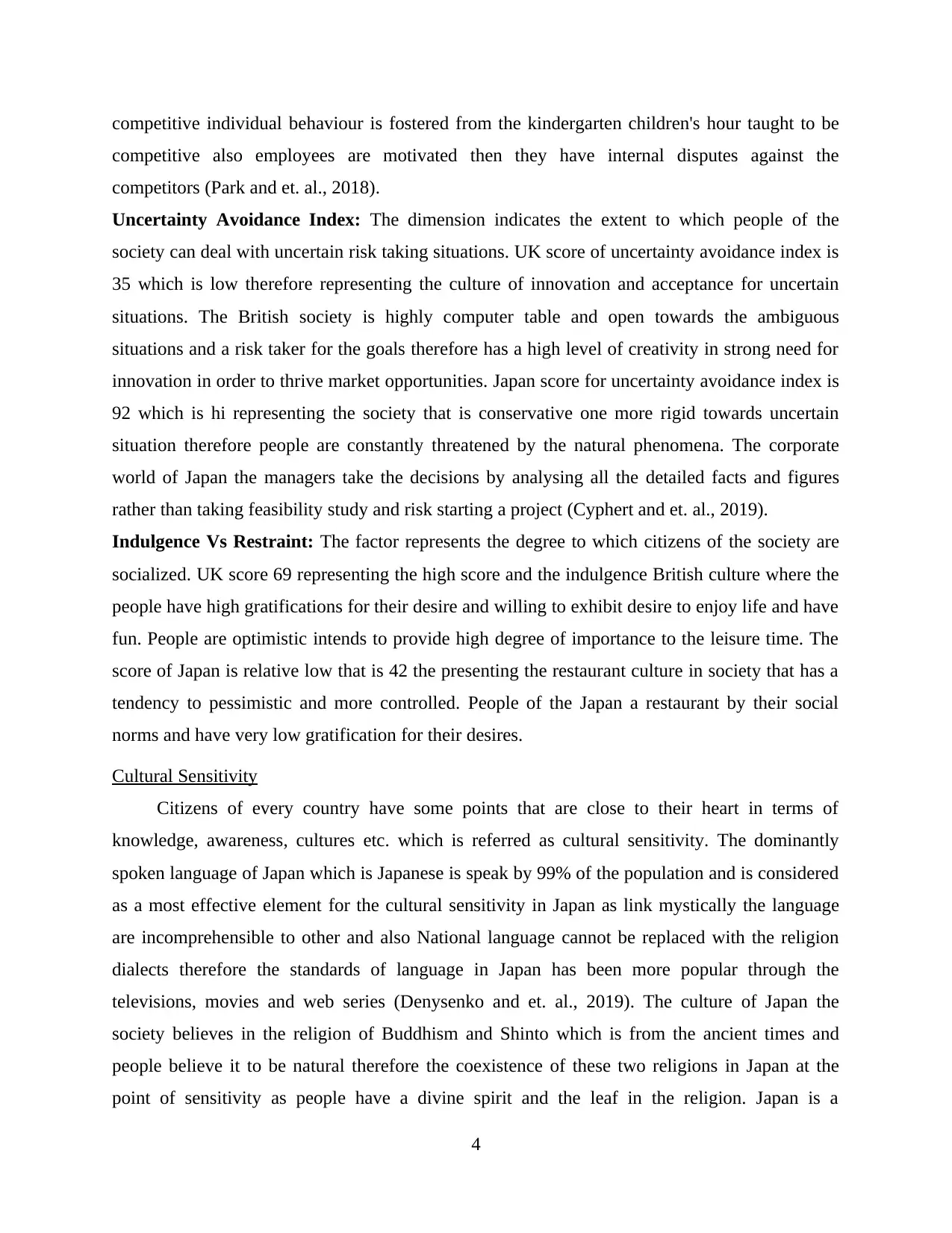
competitive individual behaviour is fostered from the kindergarten children's hour taught to be
competitive also employees are motivated then they have internal disputes against the
competitors (Park and et. al., 2018).
Uncertainty Avoidance Index: The dimension indicates the extent to which people of the
society can deal with uncertain risk taking situations. UK score of uncertainty avoidance index is
35 which is low therefore representing the culture of innovation and acceptance for uncertain
situations. The British society is highly computer table and open towards the ambiguous
situations and a risk taker for the goals therefore has a high level of creativity in strong need for
innovation in order to thrive market opportunities. Japan score for uncertainty avoidance index is
92 which is hi representing the society that is conservative one more rigid towards uncertain
situation therefore people are constantly threatened by the natural phenomena. The corporate
world of Japan the managers take the decisions by analysing all the detailed facts and figures
rather than taking feasibility study and risk starting a project (Cyphert and et. al., 2019).
Indulgence Vs Restraint: The factor represents the degree to which citizens of the society are
socialized. UK score 69 representing the high score and the indulgence British culture where the
people have high gratifications for their desire and willing to exhibit desire to enjoy life and have
fun. People are optimistic intends to provide high degree of importance to the leisure time. The
score of Japan is relative low that is 42 the presenting the restaurant culture in society that has a
tendency to pessimistic and more controlled. People of the Japan a restaurant by their social
norms and have very low gratification for their desires.
Cultural Sensitivity
Citizens of every country have some points that are close to their heart in terms of
knowledge, awareness, cultures etc. which is referred as cultural sensitivity. The dominantly
spoken language of Japan which is Japanese is speak by 99% of the population and is considered
as a most effective element for the cultural sensitivity in Japan as link mystically the language
are incomprehensible to other and also National language cannot be replaced with the religion
dialects therefore the standards of language in Japan has been more popular through the
televisions, movies and web series (Denysenko and et. al., 2019). The culture of Japan the
society believes in the religion of Buddhism and Shinto which is from the ancient times and
people believe it to be natural therefore the coexistence of these two religions in Japan at the
point of sensitivity as people have a divine spirit and the leaf in the religion. Japan is a
4
competitive also employees are motivated then they have internal disputes against the
competitors (Park and et. al., 2018).
Uncertainty Avoidance Index: The dimension indicates the extent to which people of the
society can deal with uncertain risk taking situations. UK score of uncertainty avoidance index is
35 which is low therefore representing the culture of innovation and acceptance for uncertain
situations. The British society is highly computer table and open towards the ambiguous
situations and a risk taker for the goals therefore has a high level of creativity in strong need for
innovation in order to thrive market opportunities. Japan score for uncertainty avoidance index is
92 which is hi representing the society that is conservative one more rigid towards uncertain
situation therefore people are constantly threatened by the natural phenomena. The corporate
world of Japan the managers take the decisions by analysing all the detailed facts and figures
rather than taking feasibility study and risk starting a project (Cyphert and et. al., 2019).
Indulgence Vs Restraint: The factor represents the degree to which citizens of the society are
socialized. UK score 69 representing the high score and the indulgence British culture where the
people have high gratifications for their desire and willing to exhibit desire to enjoy life and have
fun. People are optimistic intends to provide high degree of importance to the leisure time. The
score of Japan is relative low that is 42 the presenting the restaurant culture in society that has a
tendency to pessimistic and more controlled. People of the Japan a restaurant by their social
norms and have very low gratification for their desires.
Cultural Sensitivity
Citizens of every country have some points that are close to their heart in terms of
knowledge, awareness, cultures etc. which is referred as cultural sensitivity. The dominantly
spoken language of Japan which is Japanese is speak by 99% of the population and is considered
as a most effective element for the cultural sensitivity in Japan as link mystically the language
are incomprehensible to other and also National language cannot be replaced with the religion
dialects therefore the standards of language in Japan has been more popular through the
televisions, movies and web series (Denysenko and et. al., 2019). The culture of Japan the
society believes in the religion of Buddhism and Shinto which is from the ancient times and
people believe it to be natural therefore the coexistence of these two religions in Japan at the
point of sensitivity as people have a divine spirit and the leaf in the religion. Japan is a
4
⊘ This is a preview!⊘
Do you want full access?
Subscribe today to unlock all pages.

Trusted by 1+ million students worldwide
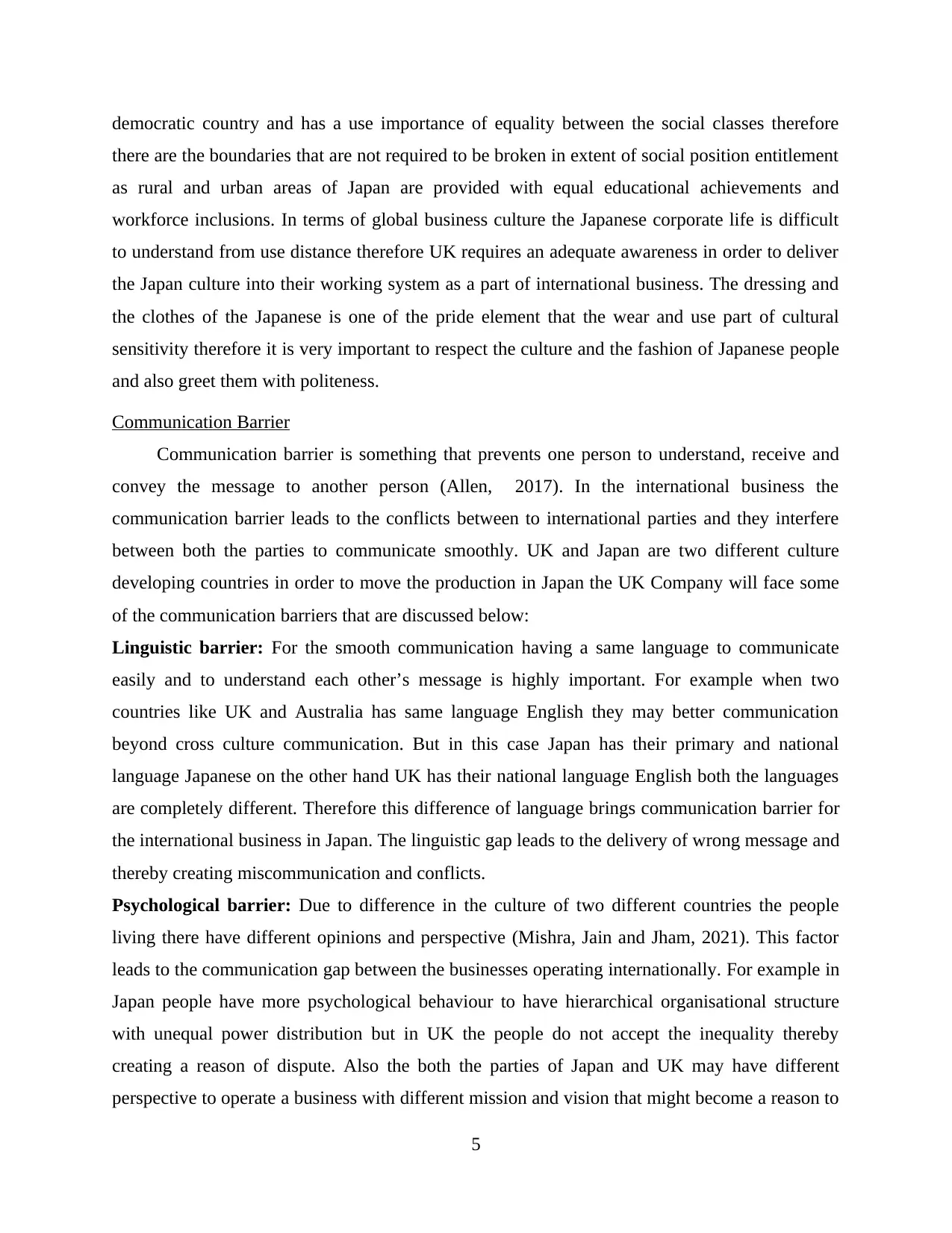
democratic country and has a use importance of equality between the social classes therefore
there are the boundaries that are not required to be broken in extent of social position entitlement
as rural and urban areas of Japan are provided with equal educational achievements and
workforce inclusions. In terms of global business culture the Japanese corporate life is difficult
to understand from use distance therefore UK requires an adequate awareness in order to deliver
the Japan culture into their working system as a part of international business. The dressing and
the clothes of the Japanese is one of the pride element that the wear and use part of cultural
sensitivity therefore it is very important to respect the culture and the fashion of Japanese people
and also greet them with politeness.
Communication Barrier
Communication barrier is something that prevents one person to understand, receive and
convey the message to another person (Allen, 2017). In the international business the
communication barrier leads to the conflicts between to international parties and they interfere
between both the parties to communicate smoothly. UK and Japan are two different culture
developing countries in order to move the production in Japan the UK Company will face some
of the communication barriers that are discussed below:
Linguistic barrier: For the smooth communication having a same language to communicate
easily and to understand each other’s message is highly important. For example when two
countries like UK and Australia has same language English they may better communication
beyond cross culture communication. But in this case Japan has their primary and national
language Japanese on the other hand UK has their national language English both the languages
are completely different. Therefore this difference of language brings communication barrier for
the international business in Japan. The linguistic gap leads to the delivery of wrong message and
thereby creating miscommunication and conflicts.
Psychological barrier: Due to difference in the culture of two different countries the people
living there have different opinions and perspective (Mishra, Jain and Jham, 2021). This factor
leads to the communication gap between the businesses operating internationally. For example in
Japan people have more psychological behaviour to have hierarchical organisational structure
with unequal power distribution but in UK the people do not accept the inequality thereby
creating a reason of dispute. Also the both the parties of Japan and UK may have different
perspective to operate a business with different mission and vision that might become a reason to
5
there are the boundaries that are not required to be broken in extent of social position entitlement
as rural and urban areas of Japan are provided with equal educational achievements and
workforce inclusions. In terms of global business culture the Japanese corporate life is difficult
to understand from use distance therefore UK requires an adequate awareness in order to deliver
the Japan culture into their working system as a part of international business. The dressing and
the clothes of the Japanese is one of the pride element that the wear and use part of cultural
sensitivity therefore it is very important to respect the culture and the fashion of Japanese people
and also greet them with politeness.
Communication Barrier
Communication barrier is something that prevents one person to understand, receive and
convey the message to another person (Allen, 2017). In the international business the
communication barrier leads to the conflicts between to international parties and they interfere
between both the parties to communicate smoothly. UK and Japan are two different culture
developing countries in order to move the production in Japan the UK Company will face some
of the communication barriers that are discussed below:
Linguistic barrier: For the smooth communication having a same language to communicate
easily and to understand each other’s message is highly important. For example when two
countries like UK and Australia has same language English they may better communication
beyond cross culture communication. But in this case Japan has their primary and national
language Japanese on the other hand UK has their national language English both the languages
are completely different. Therefore this difference of language brings communication barrier for
the international business in Japan. The linguistic gap leads to the delivery of wrong message and
thereby creating miscommunication and conflicts.
Psychological barrier: Due to difference in the culture of two different countries the people
living there have different opinions and perspective (Mishra, Jain and Jham, 2021). This factor
leads to the communication gap between the businesses operating internationally. For example in
Japan people have more psychological behaviour to have hierarchical organisational structure
with unequal power distribution but in UK the people do not accept the inequality thereby
creating a reason of dispute. Also the both the parties of Japan and UK may have different
perspective to operate a business with different mission and vision that might become a reason to
5
Paraphrase This Document
Need a fresh take? Get an instant paraphrase of this document with our AI Paraphraser
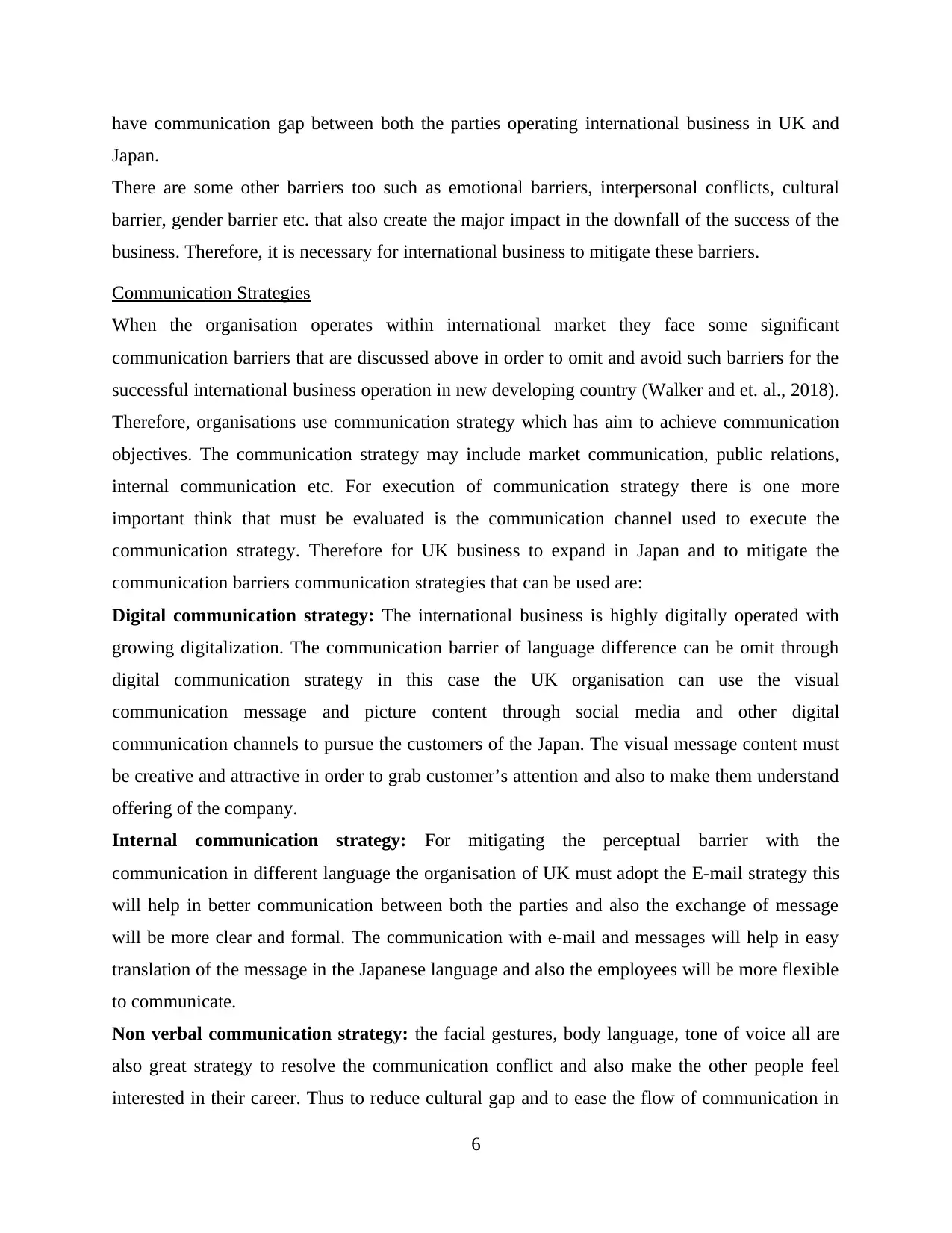
have communication gap between both the parties operating international business in UK and
Japan.
There are some other barriers too such as emotional barriers, interpersonal conflicts, cultural
barrier, gender barrier etc. that also create the major impact in the downfall of the success of the
business. Therefore, it is necessary for international business to mitigate these barriers.
Communication Strategies
When the organisation operates within international market they face some significant
communication barriers that are discussed above in order to omit and avoid such barriers for the
successful international business operation in new developing country (Walker and et. al., 2018).
Therefore, organisations use communication strategy which has aim to achieve communication
objectives. The communication strategy may include market communication, public relations,
internal communication etc. For execution of communication strategy there is one more
important think that must be evaluated is the communication channel used to execute the
communication strategy. Therefore for UK business to expand in Japan and to mitigate the
communication barriers communication strategies that can be used are:
Digital communication strategy: The international business is highly digitally operated with
growing digitalization. The communication barrier of language difference can be omit through
digital communication strategy in this case the UK organisation can use the visual
communication message and picture content through social media and other digital
communication channels to pursue the customers of the Japan. The visual message content must
be creative and attractive in order to grab customer’s attention and also to make them understand
offering of the company.
Internal communication strategy: For mitigating the perceptual barrier with the
communication in different language the organisation of UK must adopt the E-mail strategy this
will help in better communication between both the parties and also the exchange of message
will be more clear and formal. The communication with e-mail and messages will help in easy
translation of the message in the Japanese language and also the employees will be more flexible
to communicate.
Non verbal communication strategy: the facial gestures, body language, tone of voice all are
also great strategy to resolve the communication conflict and also make the other people feel
interested in their career. Thus to reduce cultural gap and to ease the flow of communication in
6
Japan.
There are some other barriers too such as emotional barriers, interpersonal conflicts, cultural
barrier, gender barrier etc. that also create the major impact in the downfall of the success of the
business. Therefore, it is necessary for international business to mitigate these barriers.
Communication Strategies
When the organisation operates within international market they face some significant
communication barriers that are discussed above in order to omit and avoid such barriers for the
successful international business operation in new developing country (Walker and et. al., 2018).
Therefore, organisations use communication strategy which has aim to achieve communication
objectives. The communication strategy may include market communication, public relations,
internal communication etc. For execution of communication strategy there is one more
important think that must be evaluated is the communication channel used to execute the
communication strategy. Therefore for UK business to expand in Japan and to mitigate the
communication barriers communication strategies that can be used are:
Digital communication strategy: The international business is highly digitally operated with
growing digitalization. The communication barrier of language difference can be omit through
digital communication strategy in this case the UK organisation can use the visual
communication message and picture content through social media and other digital
communication channels to pursue the customers of the Japan. The visual message content must
be creative and attractive in order to grab customer’s attention and also to make them understand
offering of the company.
Internal communication strategy: For mitigating the perceptual barrier with the
communication in different language the organisation of UK must adopt the E-mail strategy this
will help in better communication between both the parties and also the exchange of message
will be more clear and formal. The communication with e-mail and messages will help in easy
translation of the message in the Japanese language and also the employees will be more flexible
to communicate.
Non verbal communication strategy: the facial gestures, body language, tone of voice all are
also great strategy to resolve the communication conflict and also make the other people feel
interested in their career. Thus to reduce cultural gap and to ease the flow of communication in
6
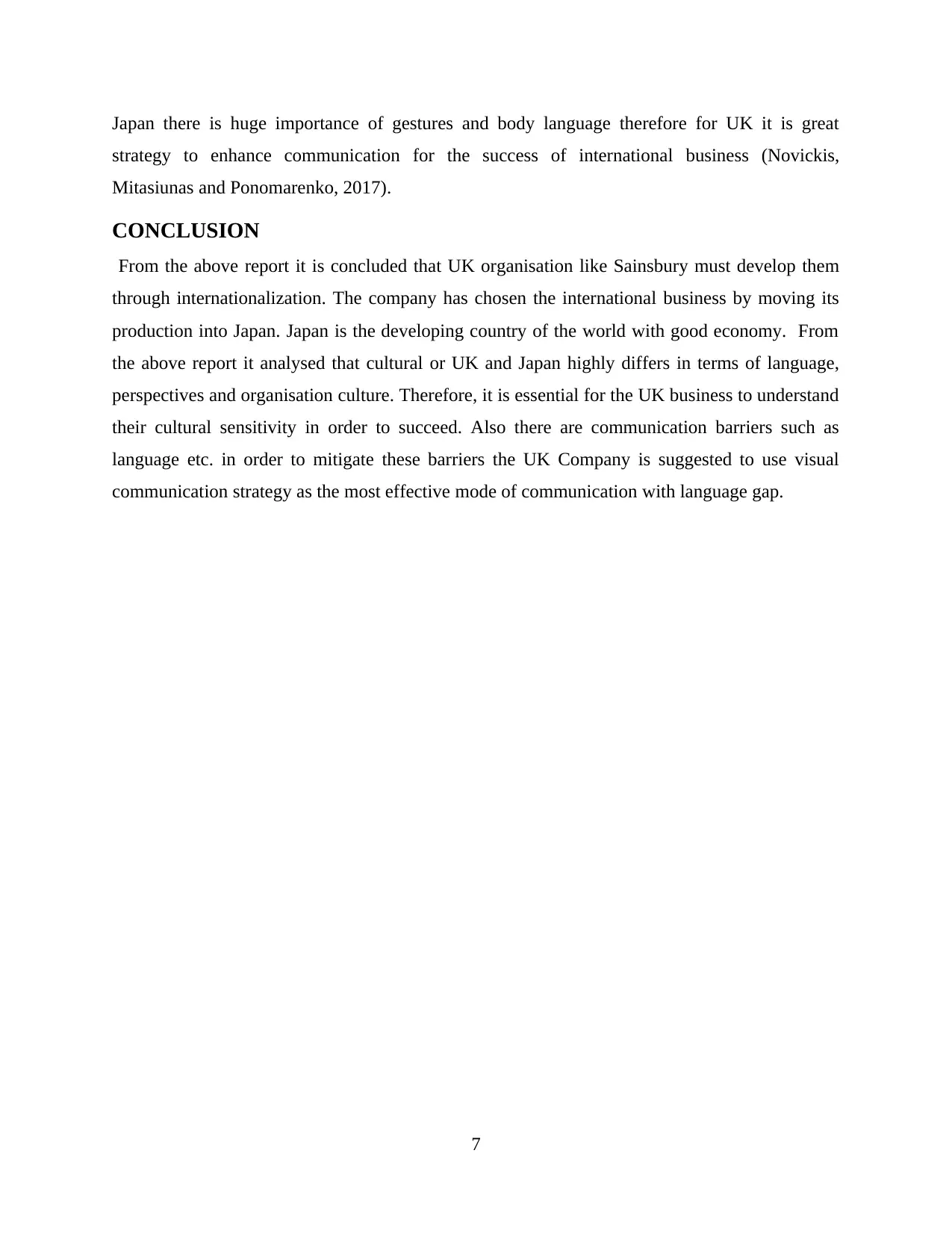
Japan there is huge importance of gestures and body language therefore for UK it is great
strategy to enhance communication for the success of international business (Novickis,
Mitasiunas and Ponomarenko, 2017).
CONCLUSION
From the above report it is concluded that UK organisation like Sainsbury must develop them
through internationalization. The company has chosen the international business by moving its
production into Japan. Japan is the developing country of the world with good economy. From
the above report it analysed that cultural or UK and Japan highly differs in terms of language,
perspectives and organisation culture. Therefore, it is essential for the UK business to understand
their cultural sensitivity in order to succeed. Also there are communication barriers such as
language etc. in order to mitigate these barriers the UK Company is suggested to use visual
communication strategy as the most effective mode of communication with language gap.
7
strategy to enhance communication for the success of international business (Novickis,
Mitasiunas and Ponomarenko, 2017).
CONCLUSION
From the above report it is concluded that UK organisation like Sainsbury must develop them
through internationalization. The company has chosen the international business by moving its
production into Japan. Japan is the developing country of the world with good economy. From
the above report it analysed that cultural or UK and Japan highly differs in terms of language,
perspectives and organisation culture. Therefore, it is essential for the UK business to understand
their cultural sensitivity in order to succeed. Also there are communication barriers such as
language etc. in order to mitigate these barriers the UK Company is suggested to use visual
communication strategy as the most effective mode of communication with language gap.
7
⊘ This is a preview!⊘
Do you want full access?
Subscribe today to unlock all pages.

Trusted by 1+ million students worldwide
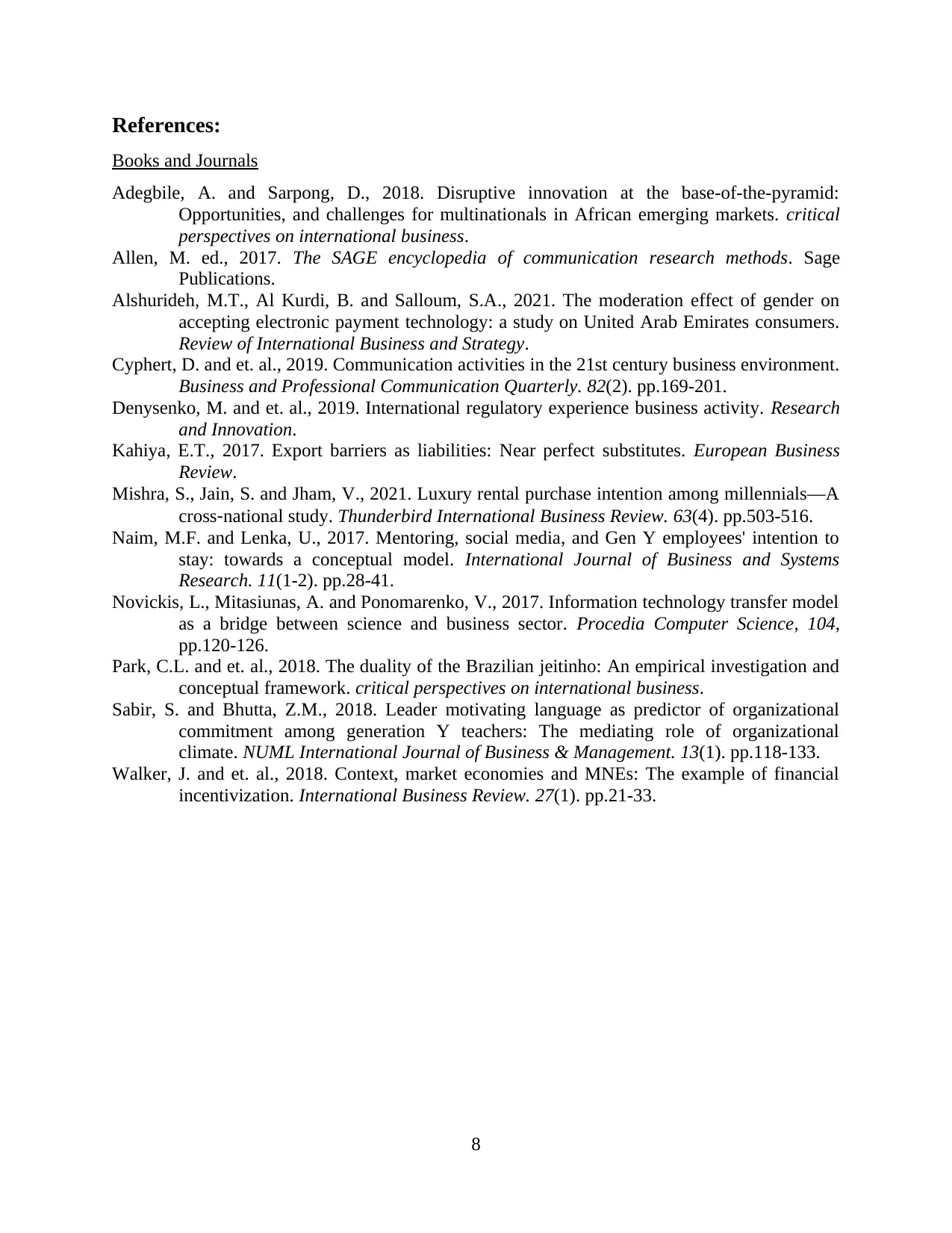
References:
Books and Journals
Adegbile, A. and Sarpong, D., 2018. Disruptive innovation at the base-of-the-pyramid:
Opportunities, and challenges for multinationals in African emerging markets. critical
perspectives on international business.
Allen, M. ed., 2017. The SAGE encyclopedia of communication research methods. Sage
Publications.
Alshurideh, M.T., Al Kurdi, B. and Salloum, S.A., 2021. The moderation effect of gender on
accepting electronic payment technology: a study on United Arab Emirates consumers.
Review of International Business and Strategy.
Cyphert, D. and et. al., 2019. Communication activities in the 21st century business environment.
Business and Professional Communication Quarterly. 82(2). pp.169-201.
Denysenko, M. and et. al., 2019. International regulatory experience business activity. Research
and Innovation.
Kahiya, E.T., 2017. Export barriers as liabilities: Near perfect substitutes. European Business
Review.
Mishra, S., Jain, S. and Jham, V., 2021. Luxury rental purchase intention among millennials—A
cross‐national study. Thunderbird International Business Review. 63(4). pp.503-516.
Naim, M.F. and Lenka, U., 2017. Mentoring, social media, and Gen Y employees' intention to
stay: towards a conceptual model. International Journal of Business and Systems
Research. 11(1-2). pp.28-41.
Novickis, L., Mitasiunas, A. and Ponomarenko, V., 2017. Information technology transfer model
as a bridge between science and business sector. Procedia Computer Science, 104,
pp.120-126.
Park, C.L. and et. al., 2018. The duality of the Brazilian jeitinho: An empirical investigation and
conceptual framework. critical perspectives on international business.
Sabir, S. and Bhutta, Z.M., 2018. Leader motivating language as predictor of organizational
commitment among generation Y teachers: The mediating role of organizational
climate. NUML International Journal of Business & Management. 13(1). pp.118-133.
Walker, J. and et. al., 2018. Context, market economies and MNEs: The example of financial
incentivization. International Business Review. 27(1). pp.21-33.
8
Books and Journals
Adegbile, A. and Sarpong, D., 2018. Disruptive innovation at the base-of-the-pyramid:
Opportunities, and challenges for multinationals in African emerging markets. critical
perspectives on international business.
Allen, M. ed., 2017. The SAGE encyclopedia of communication research methods. Sage
Publications.
Alshurideh, M.T., Al Kurdi, B. and Salloum, S.A., 2021. The moderation effect of gender on
accepting electronic payment technology: a study on United Arab Emirates consumers.
Review of International Business and Strategy.
Cyphert, D. and et. al., 2019. Communication activities in the 21st century business environment.
Business and Professional Communication Quarterly. 82(2). pp.169-201.
Denysenko, M. and et. al., 2019. International regulatory experience business activity. Research
and Innovation.
Kahiya, E.T., 2017. Export barriers as liabilities: Near perfect substitutes. European Business
Review.
Mishra, S., Jain, S. and Jham, V., 2021. Luxury rental purchase intention among millennials—A
cross‐national study. Thunderbird International Business Review. 63(4). pp.503-516.
Naim, M.F. and Lenka, U., 2017. Mentoring, social media, and Gen Y employees' intention to
stay: towards a conceptual model. International Journal of Business and Systems
Research. 11(1-2). pp.28-41.
Novickis, L., Mitasiunas, A. and Ponomarenko, V., 2017. Information technology transfer model
as a bridge between science and business sector. Procedia Computer Science, 104,
pp.120-126.
Park, C.L. and et. al., 2018. The duality of the Brazilian jeitinho: An empirical investigation and
conceptual framework. critical perspectives on international business.
Sabir, S. and Bhutta, Z.M., 2018. Leader motivating language as predictor of organizational
commitment among generation Y teachers: The mediating role of organizational
climate. NUML International Journal of Business & Management. 13(1). pp.118-133.
Walker, J. and et. al., 2018. Context, market economies and MNEs: The example of financial
incentivization. International Business Review. 27(1). pp.21-33.
8
1 out of 10
Related Documents
Your All-in-One AI-Powered Toolkit for Academic Success.
+13062052269
info@desklib.com
Available 24*7 on WhatsApp / Email
![[object Object]](/_next/static/media/star-bottom.7253800d.svg)
Unlock your academic potential
Copyright © 2020–2025 A2Z Services. All Rights Reserved. Developed and managed by ZUCOL.



